Search Result
Results for "
BDP
" in MedChemExpress (MCE) Product Catalog:
2
Biochemical Assay Reagents
1
Isotope-Labeled Compounds
| Cat. No. |
Product Name |
Target |
Research Areas |
Chemical Structure |
-
- HY-D1666
-
|
|
Fluorescent Dye
|
Others
|
|
BDP 558/568 azide is an azide modified BDP 558/568 (BDP 558/568: Ex=558 nm, Em=568 nm). BDP 558/568 azide can be used in the labeling of click chemistry.
|
-
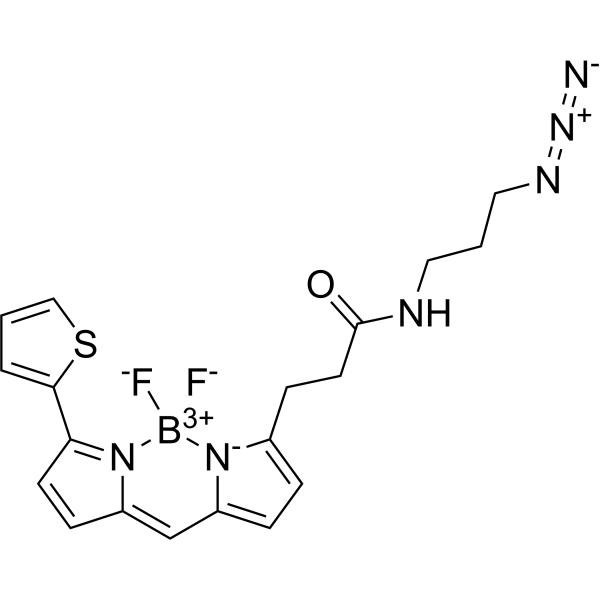
-
- HY-D1667
-
|
|
Fluorescent Dye
|
Others
|
|
BDP 558/568 hydrazide is a carbonyl reactive hydrazide derivative of BDP 558/568 (BDP 558/568: Ex=558 nm, Em=568 nm). BDP 558/568 hydrazide can be used for the labeling of aldehydes or ketones.
|
-
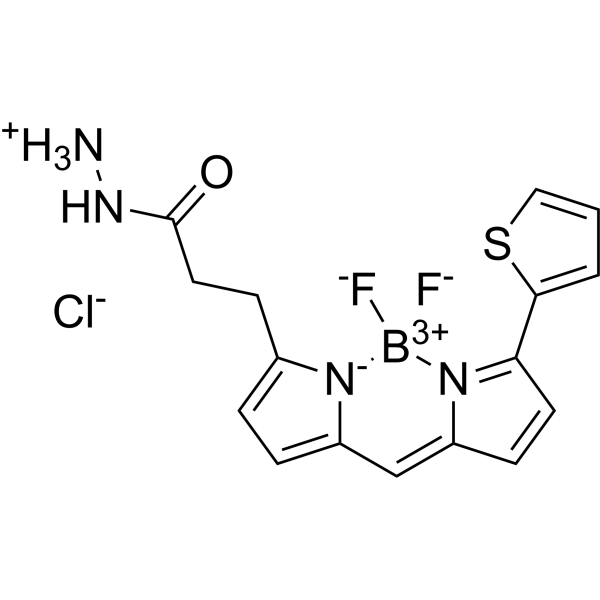
-
- HY-D1348
-
|
|
Fluorescent Dye
|
Others
|
|
BDP R6G alkyne is an alkyne modified BDP R6G. BDP R6G is a bright and photostable dye (BDP R6G: Ex=530 nm, Em=545 nm). BDP R6G alkyne can be used for labeling using Click chemistry.
|
-

-
- HY-D1344
-
|
|
Fluorescent Dye
|
Others
|
|
BDP 630/650 azide is a bright and photostable dye azide (BDP 630/650: Ex=630 nm, Em=650 nm). BDP 630/650 azide can be used for labeling using Click chemistry.
|
-
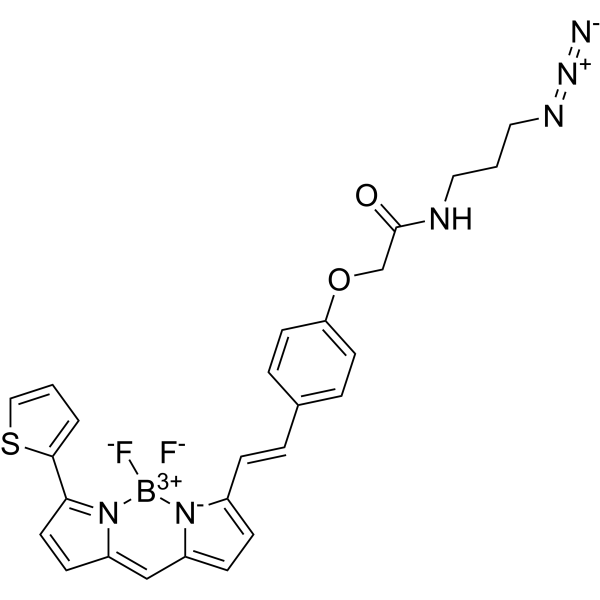
-
- HY-D2256
-
-
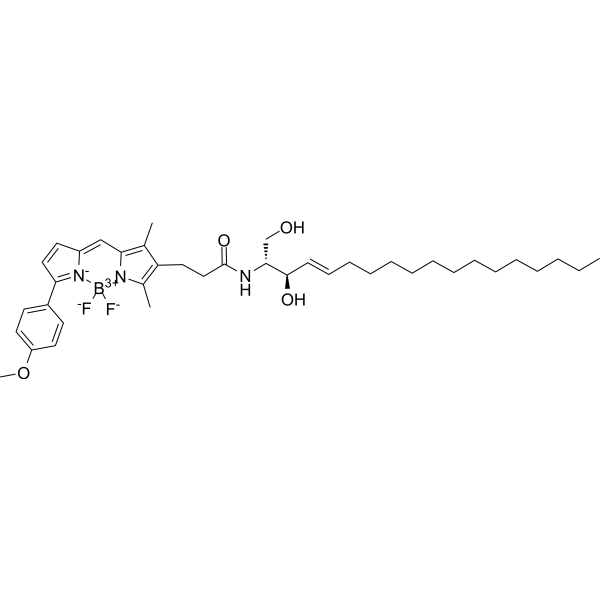
-
- HY-D1665
-
|
|
Fluorescent Dye
|
Others
|
|
BDP 558/568 amine is an amine derivative of BDP 558/568. BDP 558/568 is a borondipyrromethene dye with yellow/orange emission. BDP 558/568 amine can be conjugated by means of reactions with various electrophiles .
|
-

-
- HY-D1656
-
|
|
Fluorescent Dye
|
Others
|
|
BDP 581/591 carboxylic acid is a fluorescent dye (Ex=585 nm, Em=594 nm). BDP 581/591 carboxylic acid has a free carboxylic acid group, which can be catalyzed by a catalyst (such as EDC or HATU) to react with primary amines to form stable amide bonds. BDP 581/591 carboxylic acid is highly photostable and can be used for ROS detection.
|
-
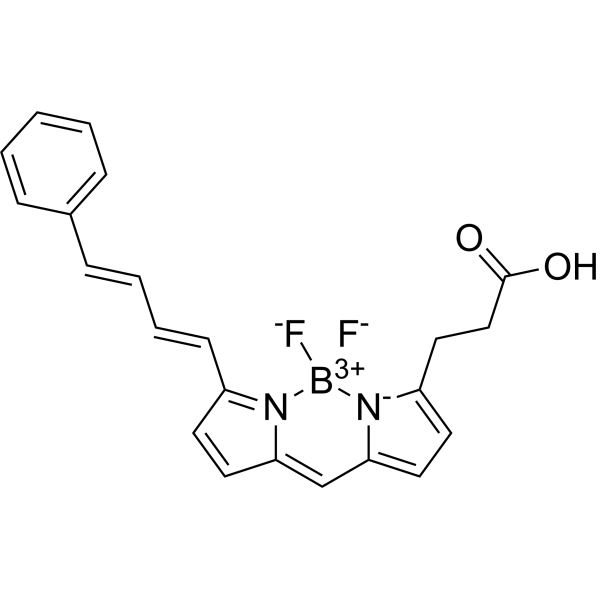
-
- HY-D1649
-
|
|
Fluorescent Dye
|
Others
|
|
BDP R6G amine is a fluorophore based on borondipyrromethene scaffold. BDP R6G amine is a BDP linker containing an amine group. BDP R6G amine is a terminal alkyne for copper-catalyzed Click chemistry. (λex=530 nm, λem=548 nm).
|
-

-
- HY-D1330
-
|
|
Fluorescent Dye
|
Others
|
|
BDP R6G azide is an anlong of BDP dye. BDP R6G azide is available that are tuned to match excitation and emission channels of classical xanthene and cyanine dyes. BDP R6G azide can be used in copper-catalyzed Click chemistry reactions with alkynes, DBCO and BCN. (λex=530 nm, λem=548 nm) .
|
-

-
- HY-D1655
-
|
|
Fluorescent Dye
|
Others
|
|
BDP 581/591 DBCO is a borondipyrromethene dye with a conjugated olefin system (Ex=585 nm, Em=594 nm). BDP 581/591 DBCO can be used as a conventional fluorophore or for the detection of ROS (after oxidation, fluorescence moves to the green part of the spectrum).
|
-
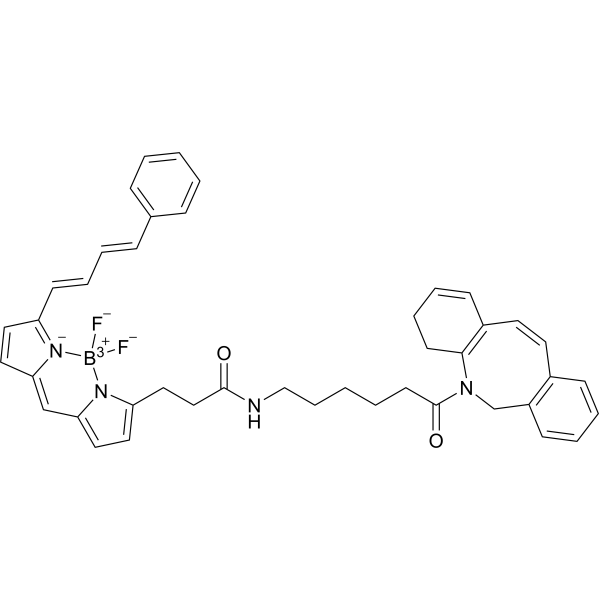
-
- HY-D1650
-
|
|
Fluorescent Dye
|
Others
|
|
BDP 630/650 carboxylic acid is a bright far-red fluorophore based on a borondipyrromethene scaffold. BDP 630/650 carboxylic acid is a BDP linker containing carboxylic acid. BDP 630/650 carboxylic acid can react with primary amine groups to form a stable amide bond. (λex=630 nm, λem=650 nm) .
|
-
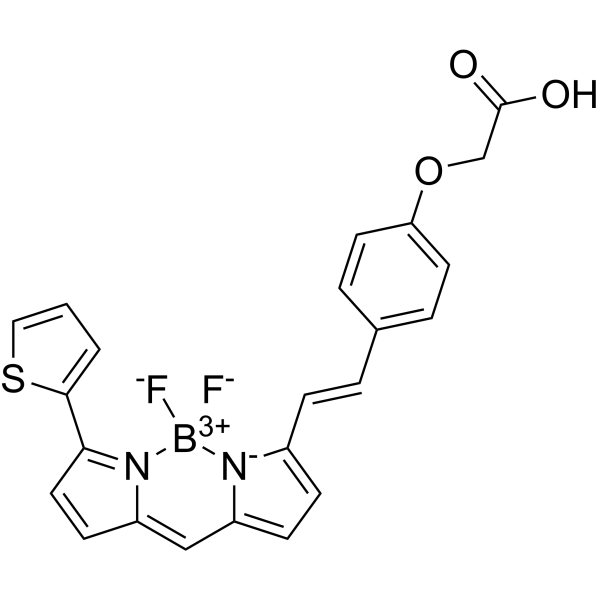
-
- HY-D1662
-
|
BODIPY 558/568SE
|
Fluorescent Dye
|
Others
|
|
BDP 558/568 NHS ester is a borondipyrromethene fluorophore with emission in the yellow part of the spectrum. BDP 558/568 NHS ester is an amine reactive NHS ester, and the absorption and emission spectra of BDP 558/568 NHS ester are similar with TAMRA, BDP TMR, Cyanine3, and sulfo-Cyanine3 .
|
-
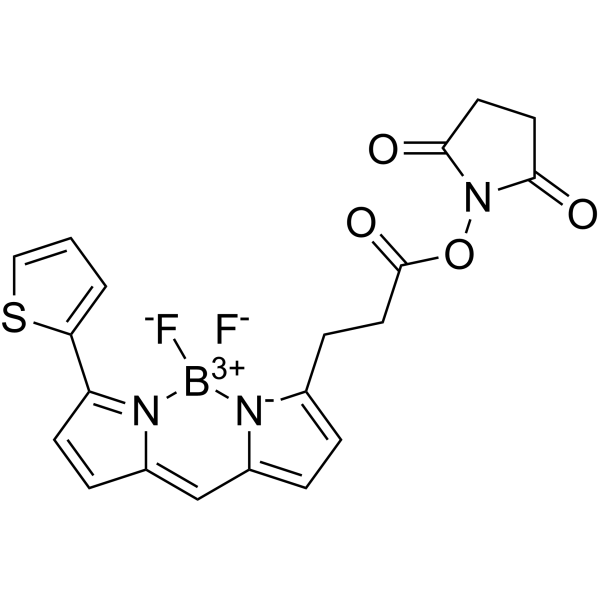
-
- HY-114353
-
|
|
Fluorescent Dye
|
Others
|
|
BDP FL azide is a BDP dye connector containing an azide group capable of Click Chemistry. The green fluorophore is representative of the borodipyrromethane class of fluorescent dyes and has a high quantum yield in aqueous environments, high stability to photobleaching and is compatible with FAM fluorescence measurement instruments .
|
-
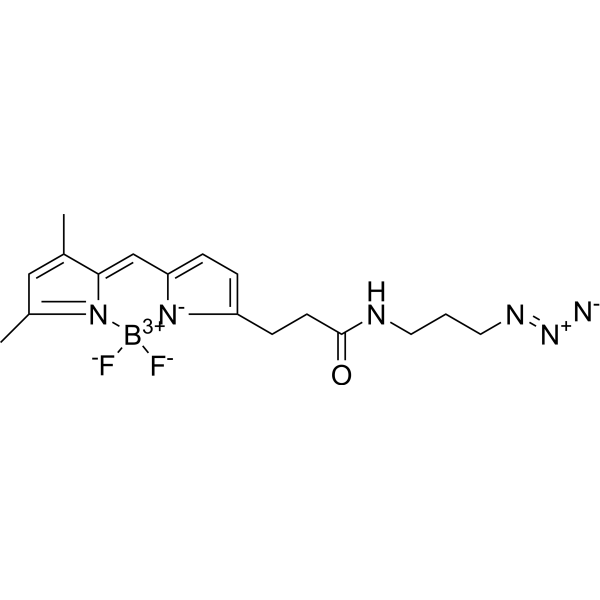
-
- HY-111578
-
|
|
Others
|
Cancer
|
|
BDP-13176 is a potent fascin 1 inhibitor, with a Kd of 90 nM and an IC50 of 240 nM. BDP-13176 has potential as an anti-metastatic agent .
|
-
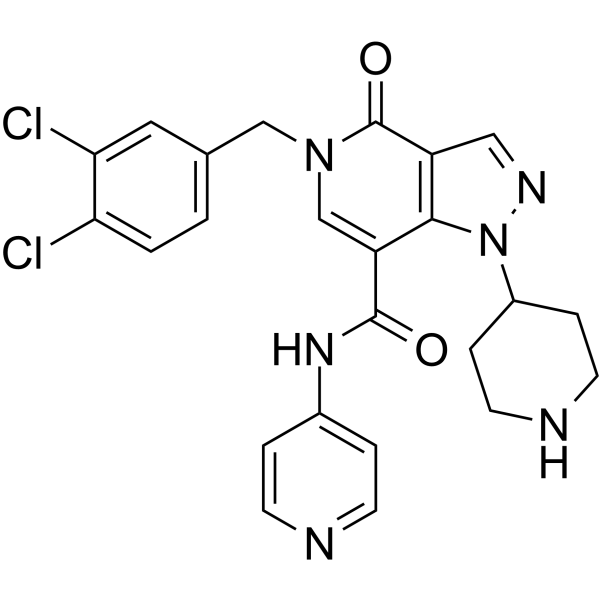
-
- HY-132266
-
|
|
Fluorescent Dye
|
Others
|
|
BDP TR carboxylic acid is a carboxylic acid derivative of BDP TR. BDP TR is a BODIPY fluorescent probe .
|
-
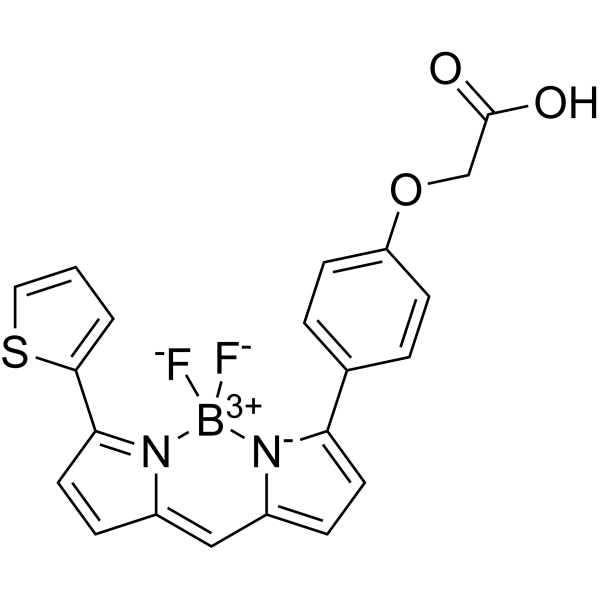
-
- HY-151751
-
|
|
Fluorescent Dye
|
Others
|
|
BDP TMR alkyne is an alkyne-containing click chemistry reagent that can click chemistry with azides. BDP TMR alkyne has the fluorophore BDP and can be used for oligonucleotide labeling and amino acid sequencing .
|
-
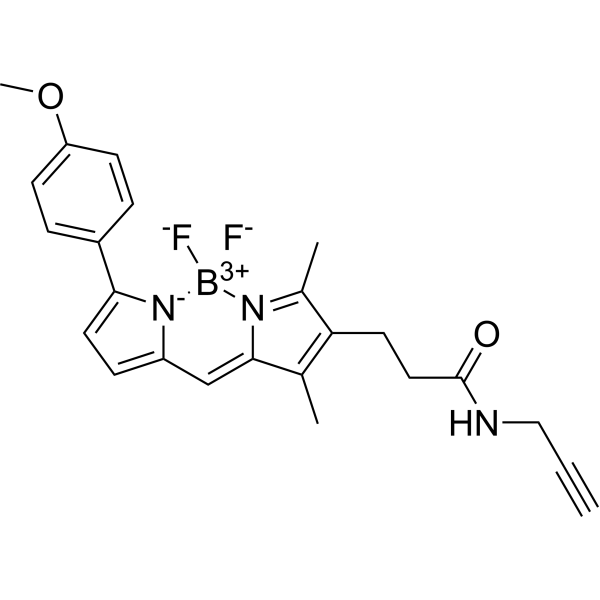
-
- HY-D1452
-
|
|
Fluorescent Dye
|
Cancer
|
|
BDP-4 is an amino acid-modified near-infrared Aza-BODIPY photosensitizer, acts as an immune initiator for potent photodynamic research in melanoma .
|
-

-
- HY-D1657
-
|
|
Fluorescent Dye
|
Others
|
|
BDP 581/591 azide is an azide derivative of BDP 581/591. BDP 581/591 is a universal, photostable fluorophore. BDP 581/591 azide can be used for the conjugation with both small molecules and biomolecules to construct tracers for fluorescence polarization assays and microscopy probes .
|
-

-
- HY-D1368
-
|
|
Fluorescent Dye
|
Others
|
|
BDP FL amine hydrochloride is a borondipyrromethene dye with good water solubility. BDP FL amine hydrochloride can be read on the FAM channel .
|
-
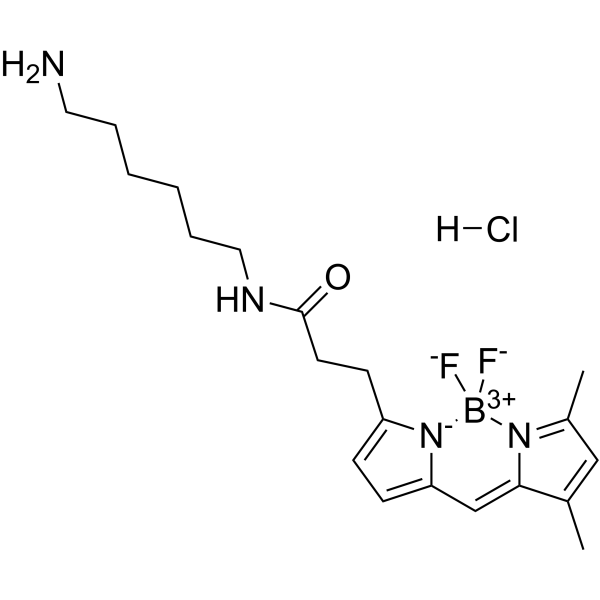
-
- HY-D1646
-
|
|
Fluorescent Dye
|
Others
|
|
BDP TR methyltetrazine is a BDP dye linker containing a methyltetrazine group. BDP TR methyltetrazine is a click chemistry reagent, it contains a Tetrazine group that can undergo an inverse electron demand Diels-Alder reaction (iEDDA) with molecules containing TCO groups.
|
-
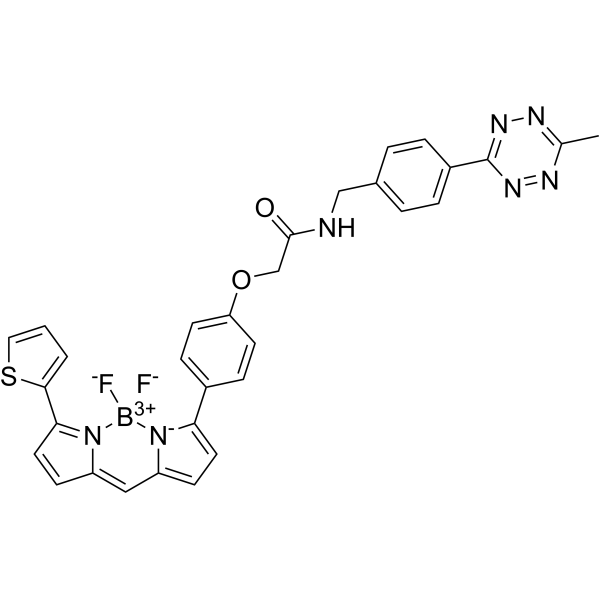
-
- HY-D2255
-
|
|
Fluorescent Dye
|
Others
|
|
BDP FL ceramide, a highly fluorescent lipid, is a conjugate of green-emitting BDP FL fluorophore with sphingosine. BDP FL ceramide can be used for the visualization of the Golgi apparatus via fluorescence microscopy.The excitation wavelength is 503 nm and the emission wavelength is 509 nm .
|
-
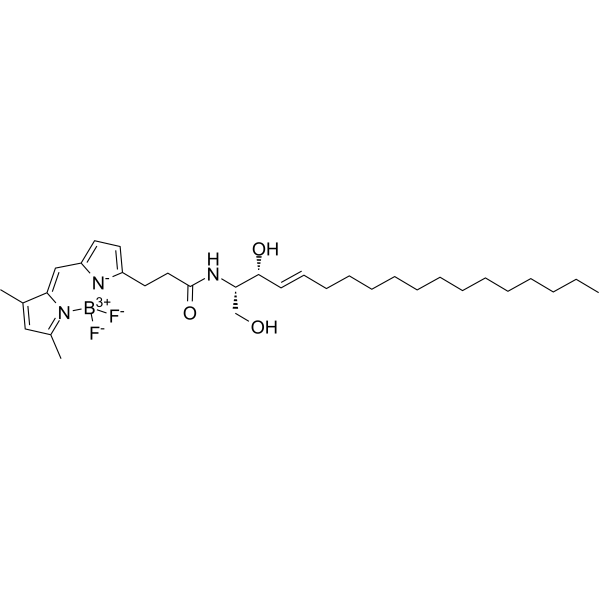
-
- HY-D1718
-
|
|
PROTAC Linkers
|
Cancer
|
|
BDP FL-PEG5-acid is a BDP FL acid linker containing a hydrophilic PEG spacer arm. BDP FL-PEG5-acid can be used in the synthesis of PROTACs. BDP FL is a green-fluorescent dye, and the hydrophilic PEG spacer arm increases water solubility and membrane permability.
|
-
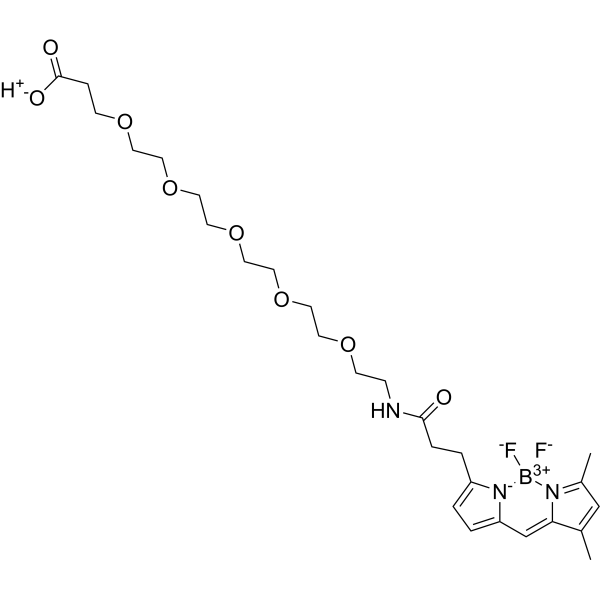
-
- HY-D2257
-
|
|
Fluorescent Dye
|
Others
|
|
BDP TR ceramide is a red fluorescent dye with a terminal sphingosine group. BDP TR ceramide can be used to study lipids microscopically .
|
-

-
- HY-D1664
-
|
|
Fluorescent Dye
|
Others
|
|
BDP 558/568 alkyne is a borondipyrromethene dye. BDP 558/568 alkyne possesses high quantum yield. BDP 558/568 alkyne is a terminal alkyne for copper-catalyzed Click chemistry. (λex=558 nm, λem=568 nm) .
|
-

-
- HY-114350
-
|
|
Fluorescent Dye
|
Others
|
|
BDP FL maleimide is a thiol-reactive dye (Ex: 503 nm; Em: 509 nm). BDP FL maleimide can be used for protein labeling, peptide modification, and can replace fluorescein (FAM) for microscopy .
|
-
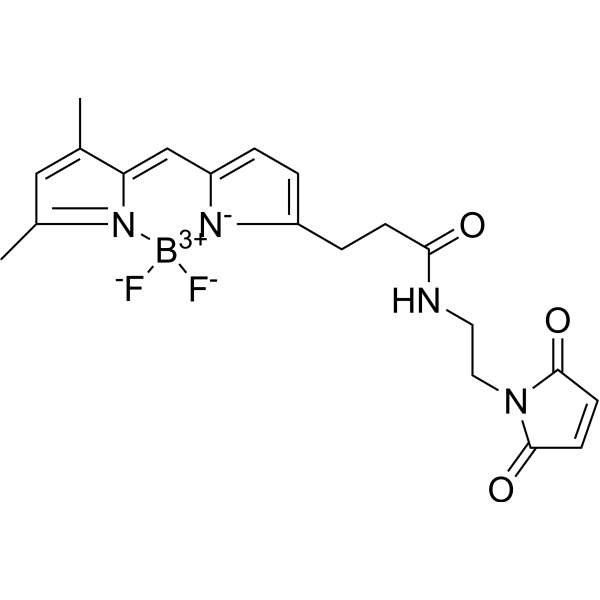
-
- HY-151775
-
|
|
Fluorescent Dye
|
Others
|
|
BDP TR azide is a click chemistry reagent containing an azide group that can react with alkynes, DBCO and BCN. BDP TR azide is also a fluorescent dye that can be used in fluorescence polarization assays and microscopy.
|
-
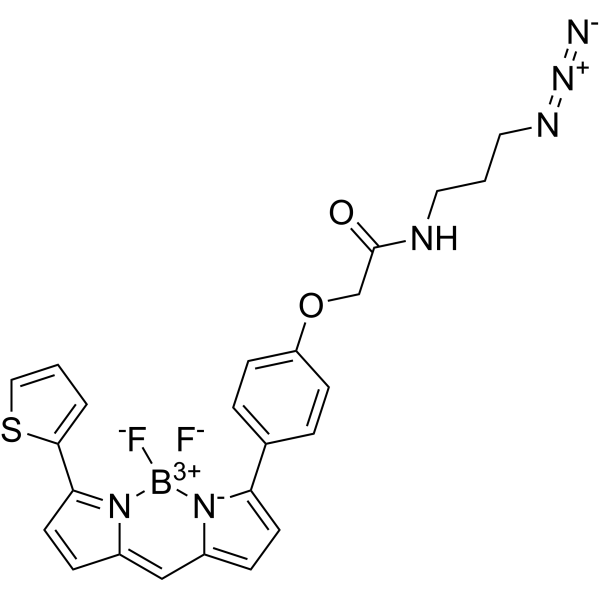
-
- HY-D1651
-
|
|
Fluorescent Dye
|
Others
|
|
BDP 630/650 amine is a far-red luminescent, boron-dipyridyl fluorophore. BDP 630/650 amine can label various electron-loving compounds. (λex=630 nm, λem=650 nm).
|
-
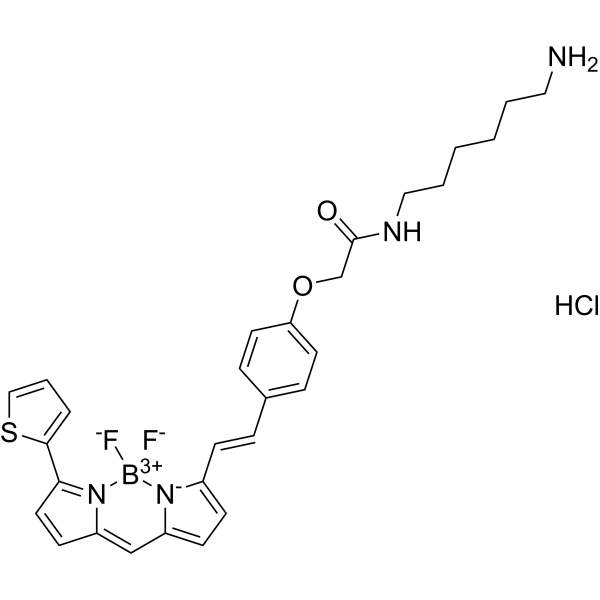
-
- HY-D1362
-
|
|
Fluorescent Dye
|
Others
|
|
BDP 630/650 maleimide is a fluorophore which can be read on the Cyanine5 channel. BDP 630/650 maleimide is useful for fluorescence lifetime related measurements because of the long life time of the excited state .
|
-
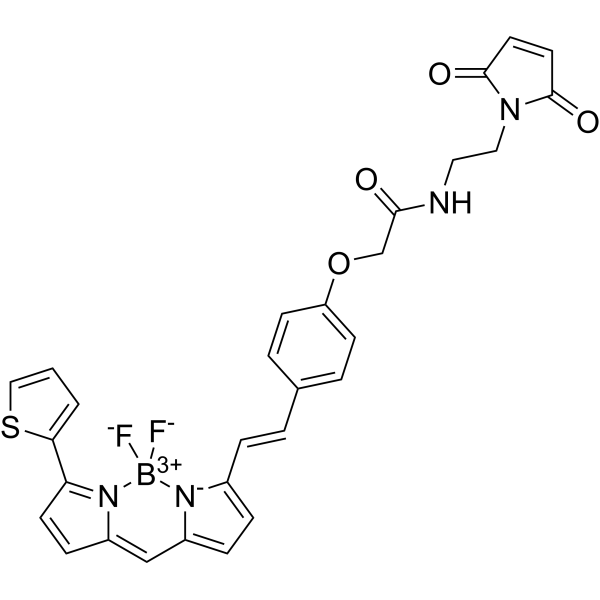
-
- HY-D1658
-
|
|
Fluorescent Dye
|
Others
|
|
BDP 581/591 amine hydrochloride is a BODIPY dye linker. BDP 581/591 is a universal, photostable fluorophore. The addition of the amine group allows for the compound to react with carboxylic acids, activated NHS esters and other carbonyl groups .
|
-

-
- HY-D1659
-
-

-
- HY-10933
-
CX516
1 Publications Verification
BDP 12
|
iGluR
|
Neurological Disease
|
|
CX516 (BDP 12) is an ampakine and acts as an AMPA receptor positive allosteric modulator for the research of Alzheimer's disease, schizophrenia and mild cognitive impairment (MCI) .
|
-
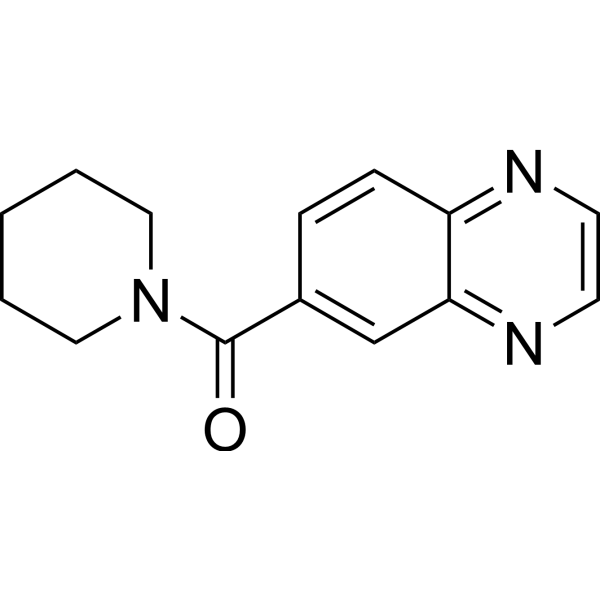
-
- HY-140296
-
|
|
Fluorescent Dye
|
Others
|
|
BDP FL DBCO is a photostable boron dipyrromethene used in the FAM (fluorescein) channel, with compatible property for fluorescein filters. BDP FL DBCO contains DBCO (azadibenzocyclooctyne) groups that enable copper-free catalyzed click chemistry reactions with azides. λex/λem= 503 nm/512 nm .
|
-
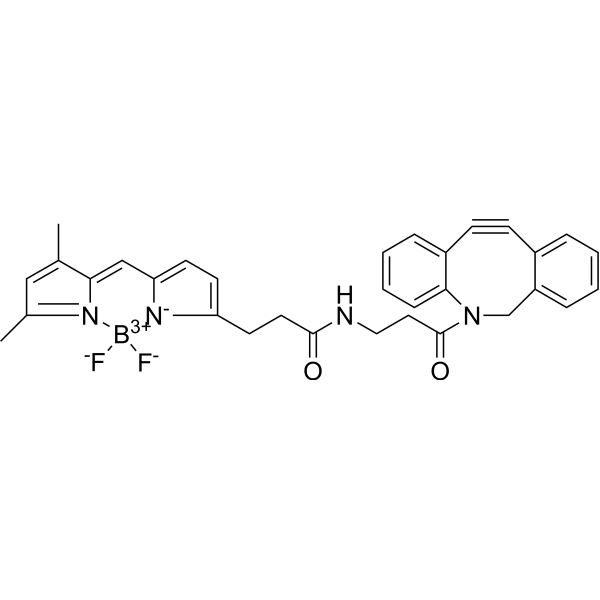
-
- HY-111424
-
|
|
Ras
|
Cancer
|
|
BDP9066 is a potent and selective myotonic dystrophy-related Cdc42-binding kinase MRCK inhibitor with an IC50 of 64 nM for MRCKβ in SCC12 cells, Ki values of 0.0136 nM and 0.0233 nM for MRCKα/β in house determinations, respectively. BDP9066 has therapeutic effect on skin cancer by reducing substrate phosphorylation.
|
-
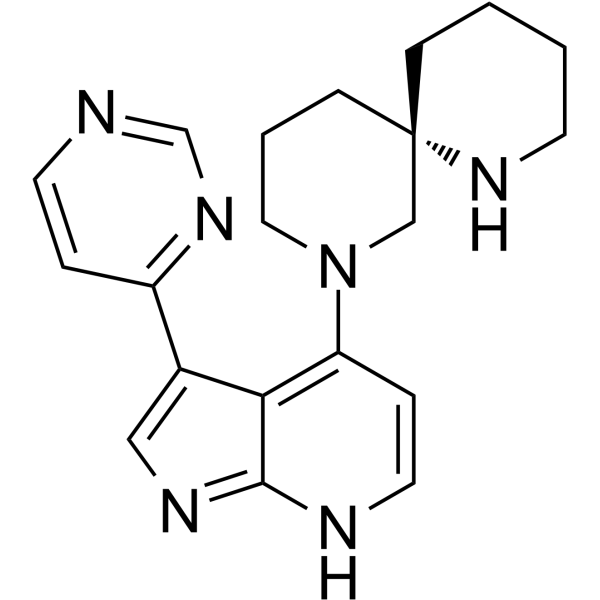
-
- HY-D1653
-
|
|
Reactive Oxygen Species
|
Others
|
|
BDP 581/591 NHS ester is a a borondipyrromethene dye (Ex=585 nm, Em=594 nm) that has relatively long fluorescence lifetime and two photon excitation cross section. BDP 581/591 NHS ester can be used for fluorescence polarization analysis and also reacts with reactive oxygen species (ROS) and alter fluorescence. BDP 581/591 NHS ester is also an NHS ester derivative that can be used to bind primary and secondary amine groups of proteins, peptides and other molecules.
|
-
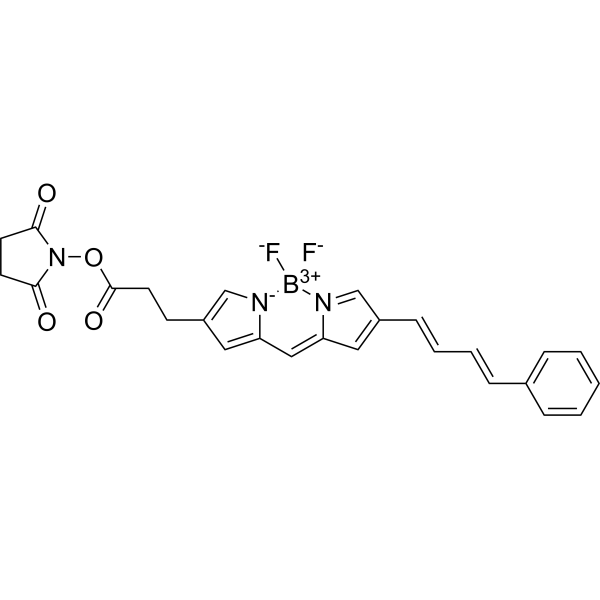
-
- HY-D1654
-
|
|
Fluorescent Dye
|
Others
|
|
BDP 581/591 maleimide is a linker of the BDP 581/591 dye. It has a long fluorescence lifetime and can be used for fluorescence polarization assays. The maleimide group can react with thiol groups to form thioester bonds between pH 6.5 to 7.5, for the labeling of sulfhydryl groups of proteins and peptides.
|
-
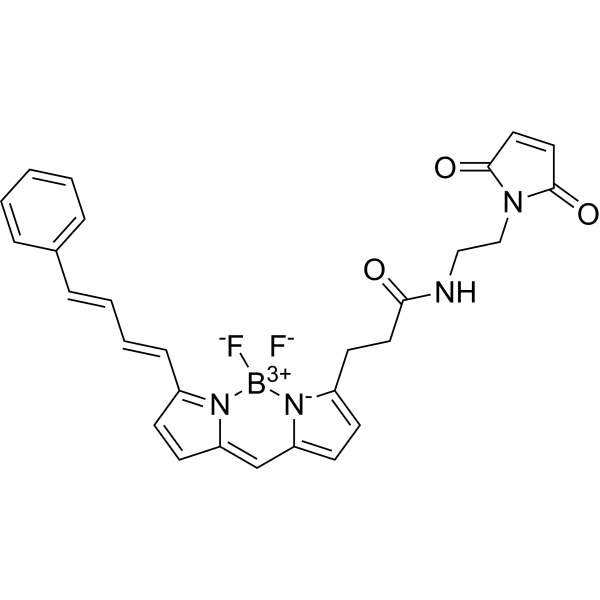
-
- HY-12437
-
|
|
ROCK
|
Cancer
|
|
BDP5290 is a potent inhibitor of both ROCK and MRCK with IC50s of 5 nM, 50 nM, 10 nM and 100 nM for ROCK1, ROCK2, MRCKα and MRCKβ, respectively.
|
-
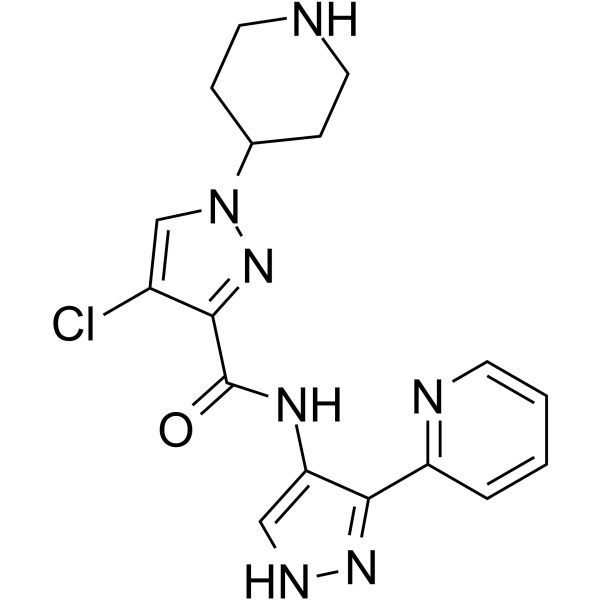
-
- HY-D1169
-
|
|
Fluorescent Dye
|
Others
|
|
BDP R6G carboxylic acid is a borondipyrromethene dye (Excitation: 530 nM; Emission: 548 nM). BDP R6G carboxylic acid terminal carboxylic acid can react with primary amine groups in the presence of activators to form a stable amide bond, for subsequent labeling reactions like Steglich esterification .
|
-
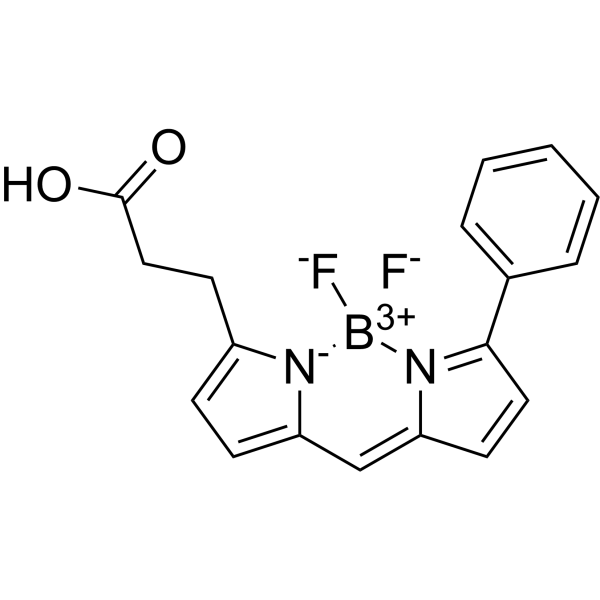
-
- HY-RS01461
-
|
|
Small Interfering RNA (siRNA)
|
Others
|
|
BDP1 Human Pre-designed siRNA Set A contains three designed siRNAs for BDP1 gene (Human), as well as a negative control, a positive control, and a FAM-labeled negative control.
|
-
BDP1 Human Pre-designed siRNA Set A
BDP1 Human Pre-designed siRNA Set A
-
- HY-D1661
-
|
|
Fluorescent Dye
|
Others
|
|
BDP 564/570 NHS ester is a lypophilic orange fluorescein dye, can be used for the labeling of amine containing biomolecules, including amine-modified oligonucleotides.
|
-

-
- HY-135083
-
|
|
PROTAC Linkers
|
Cancer
|
|
BDP FL-PEG4-amine is a PEG-based PROTAC linker that can be used in the synthesis of PROTACs .
|
-
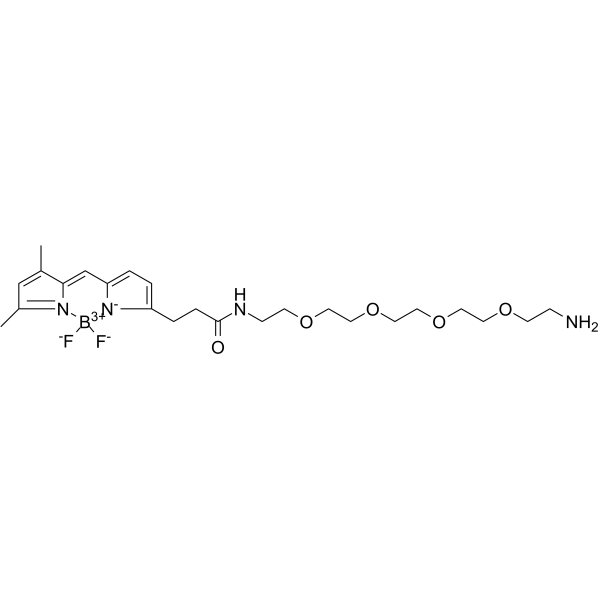
-
- HY-141086
-
|
|
PROTAC Linkers
|
Cancer
|
|
BDP FL-PEG5-azide is a PEG-based PROTAC linker that can be used in the synthesis of PROTACs .
|
-

-
- HY-141087
-
|
|
PROTAC Linkers
|
Cancer
|
|
BDP FL-PEG5-propargyl is a PEG-based PROTAC linker that can be used in the synthesis of PROTACs .
|
-
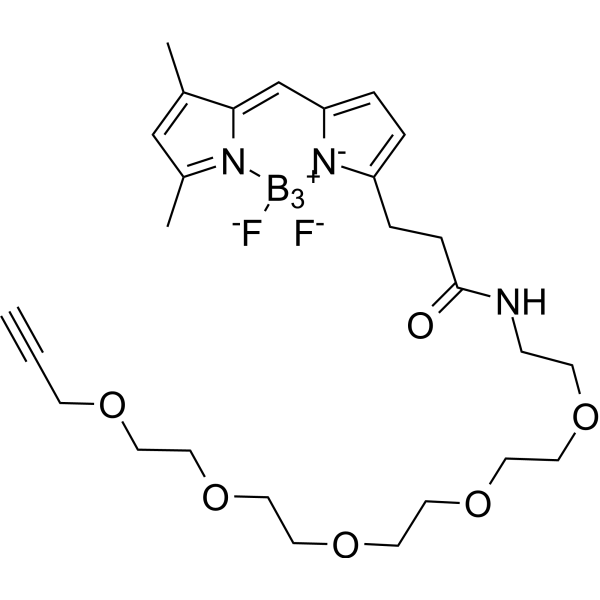
-
- HY-141088
-
|
|
PROTAC Linkers
|
Cancer
|
|
BDP FL-PEG4-TCO is a PEG-based PROTAC linker that can be used in the synthesis of PROTACs .
|
-
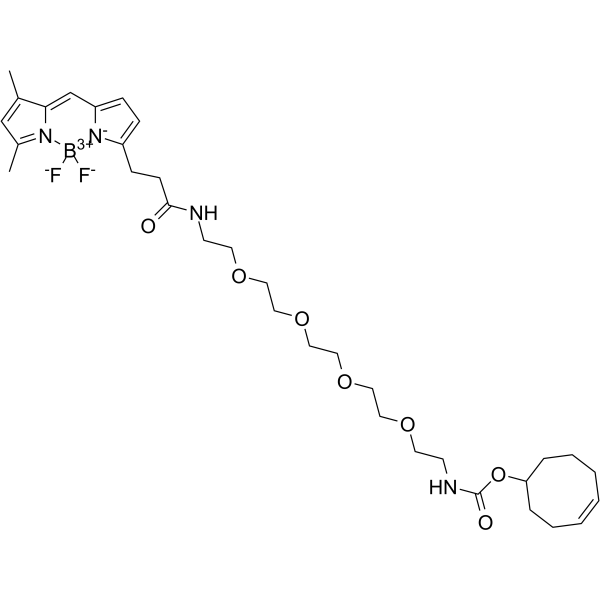
-
- HY-D1363
-
|
|
Fluorescent Dye
|
Others
|
|
BDP R6G maleimide is a borodipyrromethane fluorophore with absorption and emission wavelengths similar to those of R6G rhodamine. Sulfhydryl labelling is a common protein modification where the cysteine residues in the protein allow more site-specific labelling than the NHS ester of the amine group. BDP R6G maleimide is a thiol reactive dye that reacts with thiol groups to form thioester bonds .
|
-

-
- HY-D1333
-
|
|
Fluorescent Dye
|
Others
|
|
DP 630/650 alkyne is a red fluorescent dye with λexcitation of 630 nM and λemission of 650 nM. The terminal alkyne group can be conjugated with various azides by copper catalyzed Click chemistry. BDP 630/650 alkyne can be used for fluorescence polarization assays .
|
-

-
- HY-W414380
-
|
|
Fluorescent Dye
|
Others
|
|
Bdp tr nhs ester is a chemiluminescent coupling compound with a long excited state lifetime for immunoassays and is suitable for microscopy and fluorescence polarization analysis applications. NHS ester can react specifically and efficiently with the side chains of primary amines such as lysine residues or amino silane coated surfaces under neutral or weakly basic conditions to form covalent bonds .
|
-
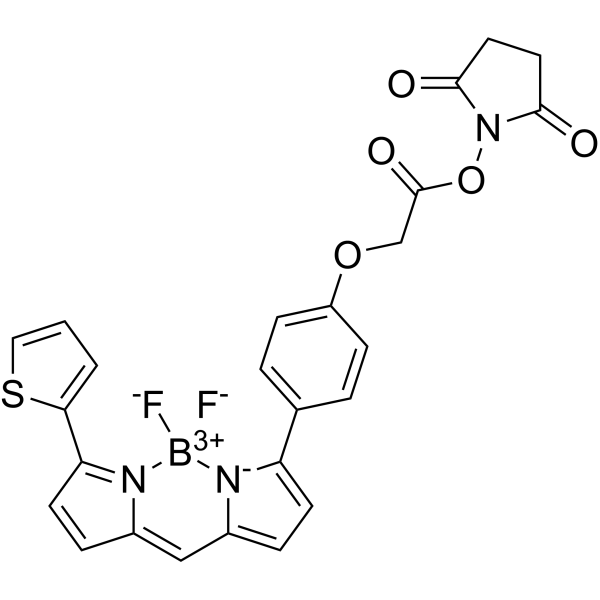
-
- HY-10933S
-
|
BDP 12-d10
|
Isotope-Labeled Compounds
iGluR
|
Neurological Disease
|
|
CX516-d10 is the deuterium labeled CX516. CX516 (BDP 12) is an ampakine and acts as an AMPA receptor positive allosteric modulator for the research of Alzheimer's disease, schizophrenia and mild cognitive impairment (MCI)[1].
|
-

-
- HY-D1906
-
|
|
Fluorescent Dye
|
Others
|
|
CellTracker Green BODIPY (compound 31) is a green fluorescent dye that acts as an intracellular environmental tracer .
|
-
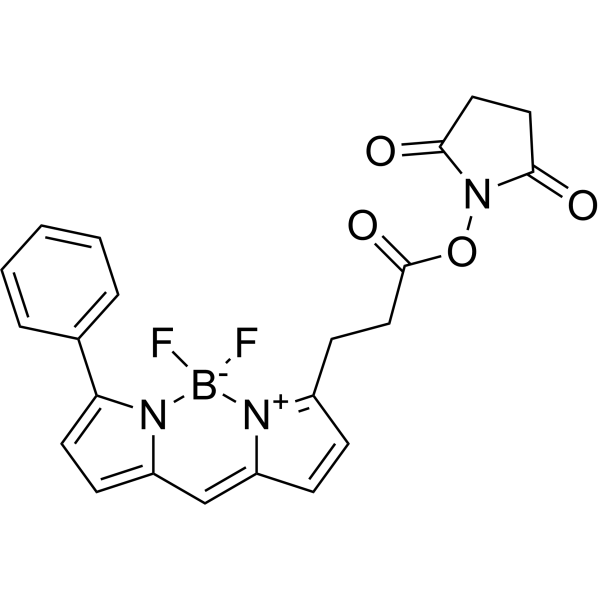
-
- HY-W090090
-
|
Pyrromethene 546; BDP 493/503 lipid stain
|
Fluorescent Dye
|
Others
|
|
BODIPY493/503 is a BODIPY dye. BODIPY dye is a small molecule dye with strong ultraviolet absorption ability, its fluorescence peak is relatively sharp, and the quantum yield is high. They are relatively insensitive to the polarity and pH of the environment and are relatively stable under different physiological conditions. Due to its structural asymmetry, BODIPY derives a variety of structural products. BODIPY lipid droplet dyes can well pass through the cell membrane into the cell, and localize the polar lipids in the cell to specifically stain the lipid droplets, which can be used for labeling of live cells and fixed cells . Maximum excitation/emission wavelength: 493/503 nm .
|
-

-
- HY-111424A
-
|
|
Others
|
Cancer
|
|
(R)-BDP9066 is a potent inhibitor of myotonic dystrophy kinase-related Cdc42-binding kinase (MRCK). (R)-BDP9066 blocks cancer cell invasion. (R)-BDP9066 has the potential for the research of proliferative diseases, such as cancer.
|
-
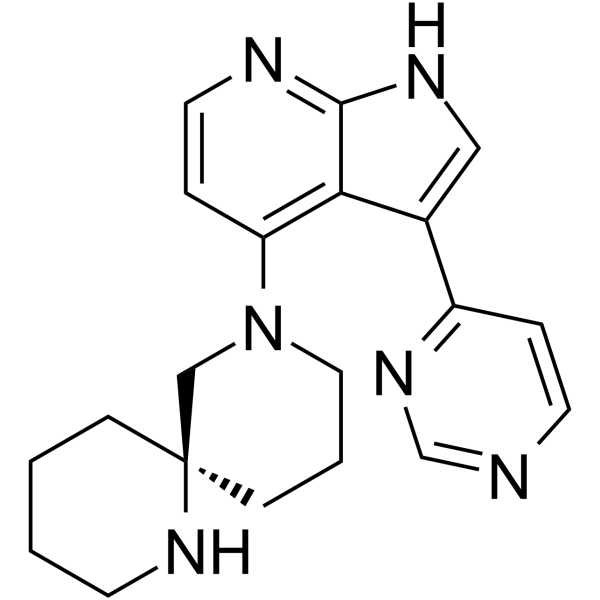
- HY-160256
-
-
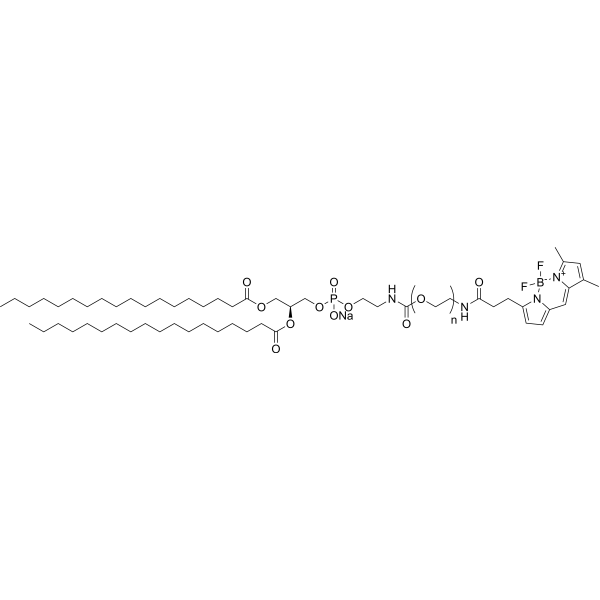
- HY-D2203
-
|
|
Fluorescent Dye
|
Cancer
|
|
BODIPY BDP4 has ssuperb sonosensitivity and high SDT efficiency against cancer cells and tumors in tumor-bearing mice .
|
-

- HY-160257
-
|
|
Biochemical Assay Reagents
Liposome
Fluorescent Dye
|
Others
|
|
DOPE-PEG-BDP FL,MW 5000 is a PEG-lipid-dye conjugate consists of a DOPE phospholipid which is an unsaturated phospholipid, a BDP FL fluorophore with featuring excitation and emission maxima at 504 and 514 nm respectively and a large PEG spacer which links the former substance together.
|
-
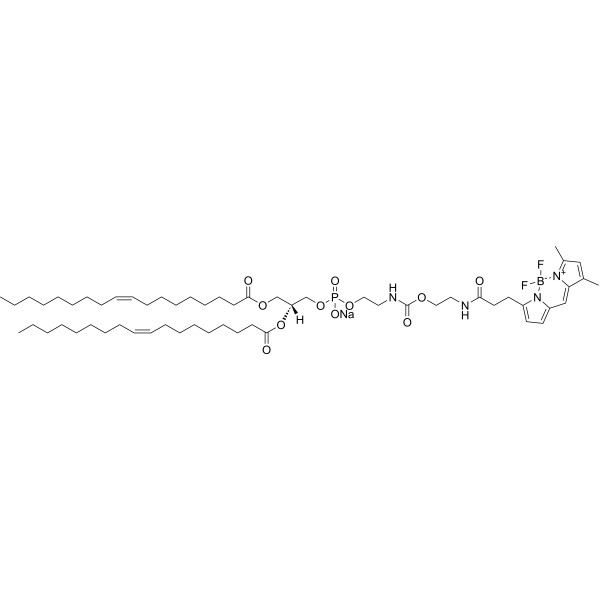
- HY-W075603
-
|
2,6-Diiodo-Pyrromethene 546; 2,6-Diiodo-BDP 493/503 lipid stain
|
Fluorescent Dye
|
Others
|
|
2,6-Diiodo-BODIPY 493/503 is an F-Bodipy fluorescent dye with diiodo substitution at the (pyrrole) 2,6 position. 2,6-Diiodo-BODIPY 493/503 has a pyrrole iodine substituent that turns it red .
|
-
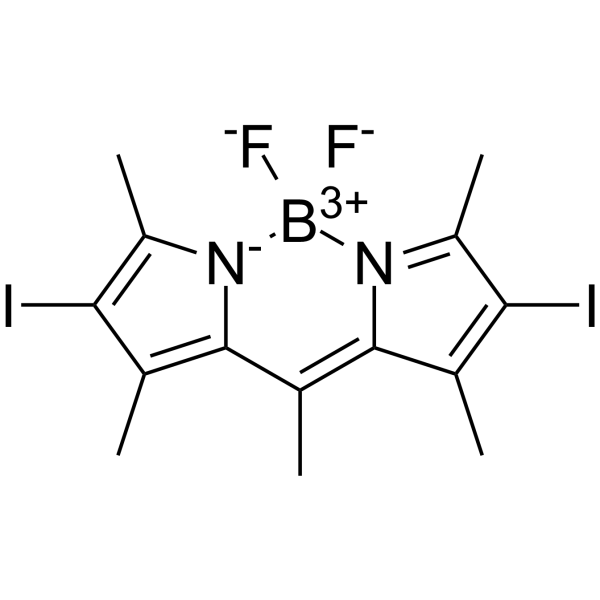
| Cat. No. |
Product Name |
Type |
-
- HY-D1666
-
|
|
Fluorescent Dyes/Probes
|
|
BDP 558/568 azide is an azide modified BDP 558/568 (BDP 558/568: Ex=558 nm, Em=568 nm). BDP 558/568 azide can be used in the labeling of click chemistry.
|
-
- HY-D1667
-
|
|
Fluorescent Dyes/Probes
|
|
BDP 558/568 hydrazide is a carbonyl reactive hydrazide derivative of BDP 558/568 (BDP 558/568: Ex=558 nm, Em=568 nm). BDP 558/568 hydrazide can be used for the labeling of aldehydes or ketones.
|
-
- HY-D1348
-
|
|
Fluorescent Dyes/Probes
|
|
BDP R6G alkyne is an alkyne modified BDP R6G. BDP R6G is a bright and photostable dye (BDP R6G: Ex=530 nm, Em=545 nm). BDP R6G alkyne can be used for labeling using Click chemistry.
|
-
- HY-D1344
-
|
|
Fluorescent Dyes/Probes
|
|
BDP 630/650 azide is a bright and photostable dye azide (BDP 630/650: Ex=630 nm, Em=650 nm). BDP 630/650 azide can be used for labeling using Click chemistry.
|
-
- HY-D2256
-
|
|
Fluorescent Dyes/Probes
|
|
BDP TMR ceramide is a BDP TMR (a water-soluble dye with a high affinity to lipid bilayers) labeled ceramide. Ex: 542 nm, Em: 572 nm .
|
-
- HY-D1665
-
|
|
Fluorescent Dyes/Probes
|
|
BDP 558/568 amine is an amine derivative of BDP 558/568. BDP 558/568 is a borondipyrromethene dye with yellow/orange emission. BDP 558/568 amine can be conjugated by means of reactions with various electrophiles .
|
-
- HY-D1656
-
|
|
Fluorescent Dyes/Probes
|
|
BDP 581/591 carboxylic acid is a fluorescent dye (Ex=585 nm, Em=594 nm). BDP 581/591 carboxylic acid has a free carboxylic acid group, which can be catalyzed by a catalyst (such as EDC or HATU) to react with primary amines to form stable amide bonds. BDP 581/591 carboxylic acid is highly photostable and can be used for ROS detection.
|
-
- HY-D1649
-
|
|
Fluorescent Dyes/Probes
|
|
BDP R6G amine is a fluorophore based on borondipyrromethene scaffold. BDP R6G amine is a BDP linker containing an amine group. BDP R6G amine is a terminal alkyne for copper-catalyzed Click chemistry. (λex=530 nm, λem=548 nm).
|
-
- HY-D1330
-
|
|
Fluorescent Dyes/Probes
|
|
BDP R6G azide is an anlong of BDP dye. BDP R6G azide is available that are tuned to match excitation and emission channels of classical xanthene and cyanine dyes. BDP R6G azide can be used in copper-catalyzed Click chemistry reactions with alkynes, DBCO and BCN. (λex=530 nm, λem=548 nm) .
|
-
- HY-D1655
-
|
|
Fluorescent Dyes/Probes
|
|
BDP 581/591 DBCO is a borondipyrromethene dye with a conjugated olefin system (Ex=585 nm, Em=594 nm). BDP 581/591 DBCO can be used as a conventional fluorophore or for the detection of ROS (after oxidation, fluorescence moves to the green part of the spectrum).
|
-
- HY-D1650
-
|
|
Fluorescent Dyes/Probes
|
|
BDP 630/650 carboxylic acid is a bright far-red fluorophore based on a borondipyrromethene scaffold. BDP 630/650 carboxylic acid is a BDP linker containing carboxylic acid. BDP 630/650 carboxylic acid can react with primary amine groups to form a stable amide bond. (λex=630 nm, λem=650 nm) .
|
-
- HY-D1662
-
|
BODIPY 558/568SE
|
Fluorescent Dyes/Probes
|
|
BDP 558/568 NHS ester is a borondipyrromethene fluorophore with emission in the yellow part of the spectrum. BDP 558/568 NHS ester is an amine reactive NHS ester, and the absorption and emission spectra of BDP 558/568 NHS ester are similar with TAMRA, BDP TMR, Cyanine3, and sulfo-Cyanine3 .
|
-
- HY-114353
-
|
|
Fluorescent Dyes/Probes
|
|
BDP FL azide is a BDP dye connector containing an azide group capable of Click Chemistry. The green fluorophore is representative of the borodipyrromethane class of fluorescent dyes and has a high quantum yield in aqueous environments, high stability to photobleaching and is compatible with FAM fluorescence measurement instruments .
|
-
- HY-151751
-
|
|
Fluorescent Dyes/Probes
|
|
BDP TMR alkyne is an alkyne-containing click chemistry reagent that can click chemistry with azides. BDP TMR alkyne has the fluorophore BDP and can be used for oligonucleotide labeling and amino acid sequencing .
|
-
- HY-D1657
-
|
|
Fluorescent Dyes/Probes
|
|
BDP 581/591 azide is an azide derivative of BDP 581/591. BDP 581/591 is a universal, photostable fluorophore. BDP 581/591 azide can be used for the conjugation with both small molecules and biomolecules to construct tracers for fluorescence polarization assays and microscopy probes .
|
-
- HY-D1368
-
|
|
Fluorescent Dyes/Probes
|
|
BDP FL amine hydrochloride is a borondipyrromethene dye with good water solubility. BDP FL amine hydrochloride can be read on the FAM channel .
|
-
- HY-D1646
-
|
|
Fluorescent Dyes/Probes
|
|
BDP TR methyltetrazine is a BDP dye linker containing a methyltetrazine group. BDP TR methyltetrazine is a click chemistry reagent, it contains a Tetrazine group that can undergo an inverse electron demand Diels-Alder reaction (iEDDA) with molecules containing TCO groups.
|
-
- HY-D2255
-
|
|
Fluorescent Dyes/Probes
|
|
BDP FL ceramide, a highly fluorescent lipid, is a conjugate of green-emitting BDP FL fluorophore with sphingosine. BDP FL ceramide can be used for the visualization of the Golgi apparatus via fluorescence microscopy.The excitation wavelength is 503 nm and the emission wavelength is 509 nm .
|
-
- HY-D2257
-
|
|
Fluorescent Dyes/Probes
|
|
BDP TR ceramide is a red fluorescent dye with a terminal sphingosine group. BDP TR ceramide can be used to study lipids microscopically .
|
-
- HY-D1664
-
|
|
Fluorescent Dyes/Probes
|
|
BDP 558/568 alkyne is a borondipyrromethene dye. BDP 558/568 alkyne possesses high quantum yield. BDP 558/568 alkyne is a terminal alkyne for copper-catalyzed Click chemistry. (λex=558 nm, λem=568 nm) .
|
-
- HY-114350
-
|
|
Fluorescent Dyes/Probes
|
|
BDP FL maleimide is a thiol-reactive dye (Ex: 503 nm; Em: 509 nm). BDP FL maleimide can be used for protein labeling, peptide modification, and can replace fluorescein (FAM) for microscopy .
|
-
- HY-151775
-
|
|
Fluorescent Dyes/Probes
|
|
BDP TR azide is a click chemistry reagent containing an azide group that can react with alkynes, DBCO and BCN. BDP TR azide is also a fluorescent dye that can be used in fluorescence polarization assays and microscopy.
|
-
- HY-D1362
-
|
|
Fluorescent Dyes/Probes
|
|
BDP 630/650 maleimide is a fluorophore which can be read on the Cyanine5 channel. BDP 630/650 maleimide is useful for fluorescence lifetime related measurements because of the long life time of the excited state .
|
-
- HY-D1658
-
|
|
Fluorescent Dyes/Probes
|
|
BDP 581/591 amine hydrochloride is a BODIPY dye linker. BDP 581/591 is a universal, photostable fluorophore. The addition of the amine group allows for the compound to react with carboxylic acids, activated NHS esters and other carbonyl groups .
|
-
- HY-D1659
-
-
- HY-D1653
-
|
|
Fluorescent Dyes/Probes
|
|
BDP 581/591 NHS ester is a a borondipyrromethene dye (Ex=585 nm, Em=594 nm) that has relatively long fluorescence lifetime and two photon excitation cross section. BDP 581/591 NHS ester can be used for fluorescence polarization analysis and also reacts with reactive oxygen species (ROS) and alter fluorescence. BDP 581/591 NHS ester is also an NHS ester derivative that can be used to bind primary and secondary amine groups of proteins, peptides and other molecules.
|
-
- HY-D1654
-
|
|
Fluorescent Dyes/Probes
|
|
BDP 581/591 maleimide is a linker of the BDP 581/591 dye. It has a long fluorescence lifetime and can be used for fluorescence polarization assays. The maleimide group can react with thiol groups to form thioester bonds between pH 6.5 to 7.5, for the labeling of sulfhydryl groups of proteins and peptides.
|
-
- HY-D1169
-
|
|
Fluorescent Dyes/Probes
|
|
BDP R6G carboxylic acid is a borondipyrromethene dye (Excitation: 530 nM; Emission: 548 nM). BDP R6G carboxylic acid terminal carboxylic acid can react with primary amine groups in the presence of activators to form a stable amide bond, for subsequent labeling reactions like Steglich esterification .
|
-
- HY-D1661
-
|
|
Fluorescent Dyes/Probes
|
|
BDP 564/570 NHS ester is a lypophilic orange fluorescein dye, can be used for the labeling of amine containing biomolecules, including amine-modified oligonucleotides.
|
-
- HY-D1363
-
|
|
Fluorescent Dyes/Probes
|
|
BDP R6G maleimide is a borodipyrromethane fluorophore with absorption and emission wavelengths similar to those of R6G rhodamine. Sulfhydryl labelling is a common protein modification where the cysteine residues in the protein allow more site-specific labelling than the NHS ester of the amine group. BDP R6G maleimide is a thiol reactive dye that reacts with thiol groups to form thioester bonds .
|
-
- HY-W414380
-
|
|
Fluorescent Dyes/Probes
|
|
Bdp tr nhs ester is a chemiluminescent coupling compound with a long excited state lifetime for immunoassays and is suitable for microscopy and fluorescence polarization analysis applications. NHS ester can react specifically and efficiently with the side chains of primary amines such as lysine residues or amino silane coated surfaces under neutral or weakly basic conditions to form covalent bonds .
|
-
- HY-D1906
-
|
|
Fluorescent Dyes/Probes
|
|
CellTracker Green BODIPY (compound 31) is a green fluorescent dye that acts as an intracellular environmental tracer .
|
-
- HY-W090090
-
|
Pyrromethene 546; BDP 493/503 lipid stain
|
Fluorescent Dyes/Probes
|
|
BODIPY493/503 is a BODIPY dye. BODIPY dye is a small molecule dye with strong ultraviolet absorption ability, its fluorescence peak is relatively sharp, and the quantum yield is high. They are relatively insensitive to the polarity and pH of the environment and are relatively stable under different physiological conditions. Due to its structural asymmetry, BODIPY derives a variety of structural products. BODIPY lipid droplet dyes can well pass through the cell membrane into the cell, and localize the polar lipids in the cell to specifically stain the lipid droplets, which can be used for labeling of live cells and fixed cells . Maximum excitation/emission wavelength: 493/503 nm .
|
-
- HY-D2203
-
|
|
Fluorescent Dyes/Probes
|
|
BODIPY BDP4 has ssuperb sonosensitivity and high SDT efficiency against cancer cells and tumors in tumor-bearing mice .
|
-
- HY-W075603
-
|
2,6-Diiodo-Pyrromethene 546; 2,6-Diiodo-BDP 493/503 lipid stain
|
Fluorescent Dyes/Probes
|
|
2,6-Diiodo-BODIPY 493/503 is an F-Bodipy fluorescent dye with diiodo substitution at the (pyrrole) 2,6 position. 2,6-Diiodo-BODIPY 493/503 has a pyrrole iodine substituent that turns it red .
|
| Cat. No. |
Product Name |
Type |
-
- HY-160256
-
|
|
Drug Delivery
|
|
DSPE-PEG-BDP FL,MW 2000 is a PEG lipid, composed of a DSPE phospholipid and a BDP FL dye .
|
-
- HY-160257
-
|
|
Drug Delivery
|
|
DOPE-PEG-BDP FL,MW 5000 is a PEG-lipid-dye conjugate consists of a DOPE phospholipid which is an unsaturated phospholipid, a BDP FL fluorophore with featuring excitation and emission maxima at 504 and 514 nm respectively and a large PEG spacer which links the former substance together.
|
| Cat. No. |
Product Name |
Chemical Structure |
-
- HY-10933S
-
|
|
|
CX516-d10 is the deuterium labeled CX516. CX516 (BDP 12) is an ampakine and acts as an AMPA receptor positive allosteric modulator for the research of Alzheimer's disease, schizophrenia and mild cognitive impairment (MCI)[1].
|
-

| Cat. No. |
Product Name |
|
Classification |
-
- HY-151751
-
|
|
|
Labeling and Fluorescence Imaging
|
|
BDP TMR alkyne is an alkyne-containing click chemistry reagent that can click chemistry with azides. BDP TMR alkyne has the fluorophore BDP and can be used for oligonucleotide labeling and amino acid sequencing .
|
-
- HY-D1666
-
|
|
|
Labeling and Fluorescence Imaging
Azide
|
|
BDP 558/568 azide is an azide modified BDP 558/568 (BDP 558/568: Ex=558 nm, Em=568 nm). BDP 558/568 azide can be used in the labeling of click chemistry.
|
-
- HY-D1646
-
|
|
|
Labeling and Fluorescence Imaging
Tetrazine
|
|
BDP TR methyltetrazine is a BDP dye linker containing a methyltetrazine group. BDP TR methyltetrazine is a click chemistry reagent, it contains a Tetrazine group that can undergo an inverse electron demand Diels-Alder reaction (iEDDA) with molecules containing TCO groups.
|
-
- HY-151775
-
|
|
|
Azide
Labeling and Fluorescence Imaging
|
|
BDP TR azide is a click chemistry reagent containing an azide group that can react with alkynes, DBCO and BCN. BDP TR azide is also a fluorescent dye that can be used in fluorescence polarization assays and microscopy.
|
-
- HY-141088
-
|
|
|
TCO
|
|
BDP FL-PEG4-TCO is a PEG-based PROTAC linker that can be used in the synthesis of PROTACs .
|
Your information is safe with us. * Required Fields.
Inquiry Information
- Product Name:
- Cat. No.:
- Quantity:
- MCE Japan Authorized Agent:





























































